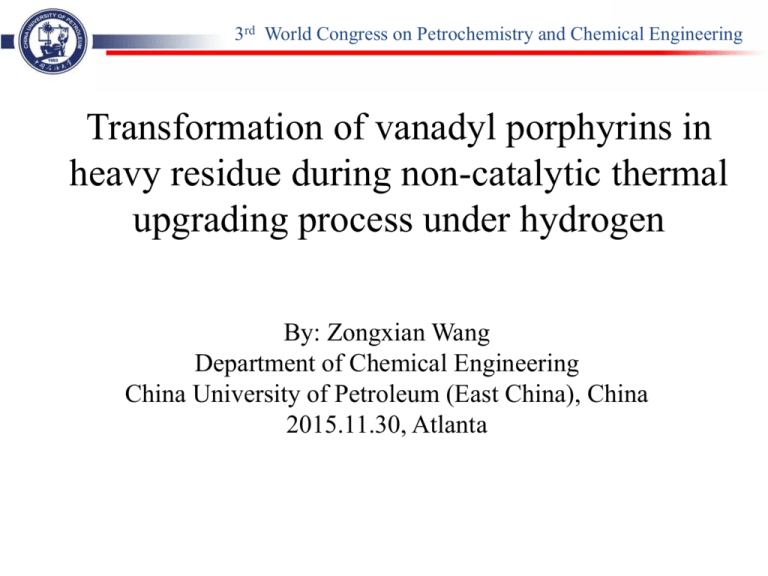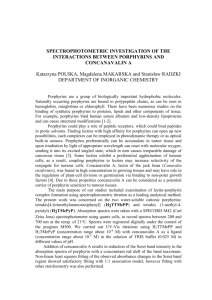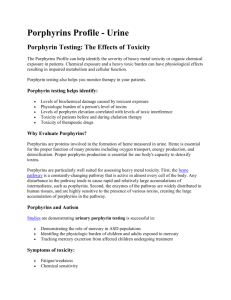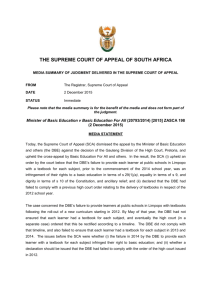Document
advertisement

3rd World Congress on Petrochemistry and Chemical Engineering Transformation of vanadyl porphyrins in heavy residue during non-catalytic thermal upgrading process under hydrogen By: Zongxian Wang Department of Chemical Engineering China University of Petroleum (East China), China 2015.11.30, Atlanta Outline Introduction Experimental section Results and discussion Conclusions Future work Acknowledgement Introduction Issues • Various kinds of heavy metals are contained in heavy oils • Vanadium and nickel are the most abundant and troublesome • Catalytic process: catalysts deactivation • Non-catalytic thermal process: coke formation Transformation of metals • Reveal the essential fate and behavior of metals • Benefit the catalysts design Introduction Research Status • Transformation of model metal porphyrins ─ mechanism, kinetics, morphology of final deposits, etc. • Transformation of petroporphyrins in real oil system ─ X-ray Absorption Fine Structure (XAFS) [1] ─ UV-vis Spectroscopy [2] ─ Electron Paramagnetic resonance (EPR) [3] ─ Fourier transform ion cyclotron resonance mass spectrometry (FTICR MS) [4] [1] Miller, J. T.; Fisher, R. B.; van der Eerden, A. M. J.; Koningsberger, D. C. Energy Fuels 1999, 13, 719-727. [2] Kekäläinen, T.; Pakarinen, J. M. H.; Wickström, K.; Lobodin, V. V.; McKenna, A. M.; Jänis, J. Energy Fuels 2013, 27, 2002-2009. [3] Ben Tayeb K.; Delpoux O.; Barbier J.; Marques J.; Verstraete J.; Vezin H. Energy Fuels 2015, 29, 4608-4615. [4] Liu, T.; Lu, J.; Zhao, X.; Zhou, Y.; Wei, Q.; Xu, C.; Zhang, Y.; Ding, S.; Zhang, T.; Tao, X. Energy Fuels 2015, 29, 20892096. Introduction Challenges and Opportunities • Low concentration of metals • High reactivity of metal compounds during hydroprocessing • Limited characterization methods of petroporphyrins Our attempts Isolation and purification of petroporphyrins Non-catalytic thermal process under hydrogen Fournier transform ion cyclotron resonance mass spectrometry (FT-ICR MS) Experimental section Sample preparation Separation scheme of petroporphyrins (CH: cyclohexane; MC: methylene chloride) Metal balance in subfractions Subfractions Yield (wt%) Ni content (ppm) V content (ppm) Ni yield (%) V yield (%) Ni/V OSAR 100 80.00 190.02 - - 0.42 Acetonitrile extract F1 51.40 29.65 103.17 19.05 27.91 0.29 36.50 12.68 0.15 5.79 0.03 84.53 F2 7.34 85.50 0.52 7.84 0.02 219.23 F3 1.87 84.24 48.51 1.97 0.48 1.74 F4 2.20 35.78 1502.16 0.98 17.39 0.02 F5 1.30 30.02 1072.34 0.49 7.34 0.03 F6 0.42 31.17 192.79 0.18 0.83 0.16 • Nickel tends to concentrate into F2 • Vanadium tends to concentrate into F4 and F5 UV-vis spectra of subfractions from OSAR • F2 presents characteristic absorptions of nickel porphyrins • F3 shows no obvious absorptions • F4, F5 and F6 show characteristic absorptions of vanadyl porphyrins • Absorptions in F6 are relatively weaker than those in F4 and F5. Thermal experiment and FT-ICR MS analysis • Thermal condition: 380 oC, 5 MPa • FT-ICR MS analysis [5-7] ─ Sample: 10 mg, diluted with 1 mL of toluene/methanol (1:1, v/v), 5 μL formic acid ─ Injection rate: 3 μL/min using a syringe pump ─ Operating conditions for positive-ion formation: -4.0 kV emitter voltage -4.5 kV capillary column introduce voltage 320 V capillary column end voltage ─ Ions accumulation: 0.1 s in a hexapole with 2.4 V direct current voltage and 500 Vp-p radio-frequency (RF) amplitude [5] Zhao, X.; Liu, Y.; Xu, C.; Yan, Y.; Zhang, Y.; Zhang, Q.; Zhao, S.; Chung, K.; Gray, M. R.; Shi, Q. Energy Fuels 2013, 27, 2874-2882. [6] Zhao, X.; Shi, Q.; Gray, M. R.; Xu, C. Nat. Sci. Rep. 2014, 4. [7] Liu, H.; Mu, J.; Wang Z.; Ji S.; Shi Q.; Guo A.; Chen K.; Lu J. Energy Fuels. 2015, 29, 4803-4813. Results and discussion UV-vis spectroscopy analysis • Decrease of the characteristic absorptions could not all account for hydrogenation of petroporphyrins ESI FT-ICR MS analysis feed 30min 60min 120min 200 400 600 800 1000 1200 m/z Broadband and expanded positive-ion ESI FT-ICR MS spectra of the feed FV and products under different reaction times (380 oC, 5 MPa). N ad N4VO porphyrins N n of ditio na ring enic h t h p N N addition of naphthenic ring VO N N VO N N N N VO N DBE=18 DBE=19 N add itio DBE=17 no fb enz e ne r N N addition of naphthenic ring N VO ing N N N DBE=20 N N N N DBE=22 N VO VO VO N S S N N N DBE=21 addition of benzothiophene N 4VOS S porphyrins N N VO N N N DBE=24 DBE=23 N 4VO2 addition of carbonyl and/or carboxyl groups porphyrins N N N VO N O N N VO N N O DBE=17 N VO N N N O DBE=18 DBE=19 Variation of DBE distribution of N4VO porphyrins • Abundance of species (DBE<17) increases slightly • Abundance of species (DBE=17) increases initially and then decreases • Abundance of species (DBE=18) decreases initially and then increases • Abundance of species (DBE>18) decreases slightly Variation of DBE distribution of N4VOS porphyrins • N4VOS porphyrins (DBE<21) could present a different structure and variation • Consistent with that of N4VO porphyrins • N4VOS porphyrins (DBE>21) may occur from N4VO porphyrins by addition of benzothiophene The possible structures of N4VOS porphyrins with DBE of 21 * Variation of carbon number distribution of N4VO porphyrins Variation of carbon number distribution of N4VOS porphyrins Variation of carbon number distribution of oxygen and/or nitrogen-containing porphyrins Expanded mass spectra at m/z 542 and 543 Conclusions Variation of DBE and carbon number distribution could indicate the hydrogenation and thermal cracking reactions of petroporphyrins, respectively. N4VOS porphyrins show very similar structural transformation with N4VO. A considerable proportion of new types of N4VO2, N4VO3 and N5VO2 are identified after thermal treatment for 30 min. Catalysts: active hydrogenolysis property and macropore size distribution Future work Effect of thermal petroporphyrins conditions on transformation of Transformation of nickel porphyrins during thermal upgrading process under hydrogen Transformation of petroporphyrins in asphaltenes under mild thermal pretreatment Acknowledgement State Key Laboratory of Heavy Oil Processing, China University of Petroleum (East China) Professor Quan Shi at China University of Petroleum (Beijing) Acknowledgement Our Research Group • Research group of heavy oil chemistry and thermal processing • Website : http://ccce.upc.edu.cn/hg/index.asp 3rd World Congress on Petrochemistry and Chemical Engineering Thank you very much for your listening







